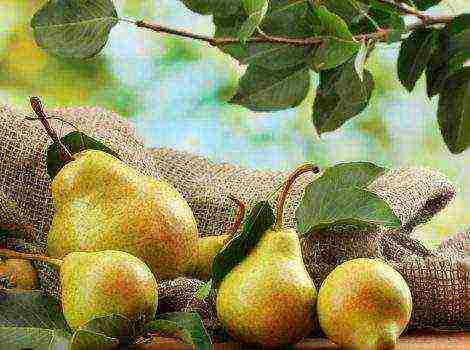Content
- 1 The history of the name of the fruit
- 2 Pomegranate tree
- 3 Types of pomegranates
- 4 Pomegranate varieties
- 5 Gulusha
- 6 Ak Dona Crimean
- 7 Achik-anor
- 8 Cossack improved
- 9 Ahmar
- 10 Nar Sharin
- 11 Dholka
- 12 Frost-resistant varieties
- 13 White variety of pomegranate
- 14 Indoor grenades
- 15 Baby
- 16 Dwarf carthage
- 17 Instead of an afterword
- 18 Excursion to the botanical garden
- 19 Pomegranate varieties: photo and description
- 20 Planting a pomegranate
- 21 Pomegranate care
- 22 Reproduction of pomegranate
- 23 Collection and storage of the harvest of pomegranates
- 24 The most common varieties of pomegranate
- 25 Product description
- 26 Video "Benefit"
- 27 Types and varieties
- 28 Benefit and harm
- 29 Video "Sorts"
In our article, we want to talk about such an exotic fruit as pomegranate. We all know from childhood about its beneficial properties. But many do not even know how it grows and which varieties of pomegranates are the best. Let's discuss this in more detail.
The history of the name of the fruit
The pomegranate is a wonderful plant. The history of its name is interesting. This plant was known back in the days of the Ancient World. Then it was believed that the best trees grow in Carthage. The Romans called the fruit malum punicum, which means "Punic apple". And the thing is that the Phoenicians in the tenth century BC moved from their native land to Africa, establishing new settlements there, including the famous Carthage. And for the Romans, the Phoenicians themselves are Punians, hence the name - the Punic apple.
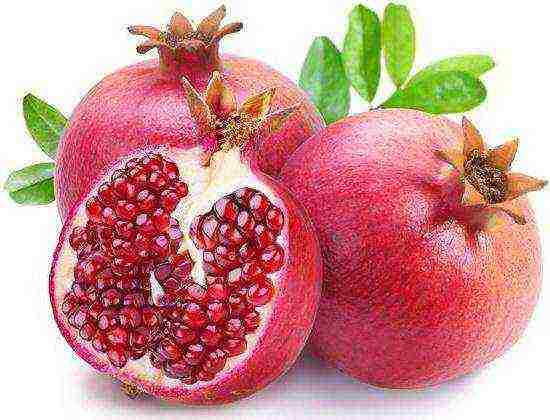
But the pomegranate also had a second name - malum granatum, which means "granular apple". It was it that later became very widespread. But the botanical name Punica was given to the plant in 1758 by Carl Linnaeus.
Pomegranate tree
There are different varieties of pomegranates in the world. The native land of the plant is Persia (the territory of modern Iran). Pomegranates grow in the wild and in the Caucasus, Central Asia, India, Asia Minor and Afghanistan. In these countries, under favorable conditions, trees can reach five meters in height, but can be a plant and a bush. At the end of the eighteenth century, thanks to the Spanish conquistadors, the culture began to be grown on the American mainland.
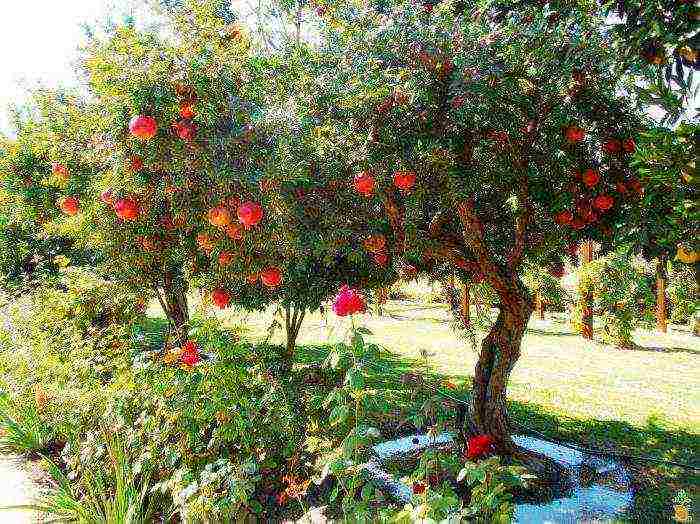
Pomegranates bloom very profusely from May to August. The large red-orange flowers of the plant are bell-like. They are so beautiful that many grow the tree just for the sake of flowering. The fruits are spherical and covered with red-brown or yellow-red skin. A pomegranate can weigh up to 600 grams. Inside it there are many seeds surrounded by juicy pulp. It is she who is edible and makes up only 50 percent of the mass of the entire fruit. Each pomegranate contains between 200 and 1400 seeds sandwiched between white septa. Fruits ripen from September to February in the northern hemisphere, and in the southern - from March to May. Up to 60 kilograms of fruit can be harvested from one tree.
The plant itself looks very decorative. In warm climates, ripe fruits crack, hanging directly from the branches. The peel breaks, but the grains are inside and do not crumble. This is just an amazing sight. In temperate climates, leaves sometimes fall off before harvesting. Fruits on bare branches give the plant an exotic touch.
Types of pomegranates
Currently, only two types of culture are known.Common pomegranate grows wild in Asia and southern Europe. The second species grows on the island of Socotra, which is located in the Arabian Sea. Hence its name - Socotransky pomegranate. But its taste is much lower than that of common pomegranate, and therefore the plant is not cultivated. In addition, recently a dwarf form of a plant has also appeared, which is grown as an ornamental crop on window sills.
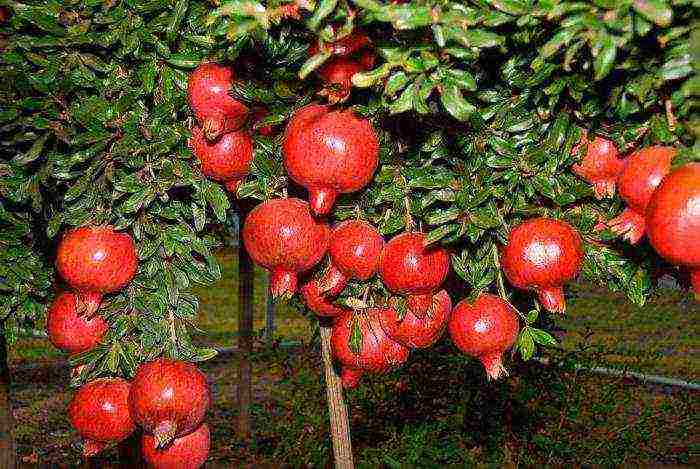
Different varieties of pomegranates, and there are more than 500 of them (cultivated varieties), have different tastes, differ in the shape and size of the fruit, the color of the pulp, the color of the juice, the softness or hardness of the seeds. The number of different varieties is increasing due to the constant work of breeders, whose main task is to create a plant that will be resistant to all diseases. There is the Kara-Kala nature reserve in Turkmenistan. Its territory contains the largest collection of pomegranates in the world. There are more than 800 forms, species, varieties of pomegranate in it.
Pomegranate varieties
We have already mentioned that there are many varieties of pomegranates. They are all grown for specific purposes. Some for fresh consumption, others for processing and juice production. From pomegranates of one variety, a wonderful and healthy drink is obtained, rich in vitamins and microelements. There are also varieties grown for technical processing. In our article, we want to list the best varieties of pomegranates and their characteristics. The cultivated species can be roughly divided into the following groups to show only a small part of the available varieties:
- Sweet Iranian varieties - Sharoli, Halva, Aswad, Akhmar.
- Very sweet Indian - Dholka.
- Sweet and sour varieties - Ulfa, Kyzym, Kok, Wellis.
- Sweet ones - Lodzhuar, Kadan, Vedana, Nar Shirin.
- American seedless variety (soft bones) - Wonderful.
- Israeli varieties - Ras el Bahl, Malissi, Red Loufani, Mangulati.
- Indian - Alandi, Bedana.
- Crimean and Transcaucasian varieties that ripen in October - Veles, Kaim nar, Krmyzy kabukh, Shah-par, Bala-myursal, Galyusha pink, Galyusha red.
- Sweet and sour Central Asian varieties - Kzyl-anar, Achik-Dona, Kazake-anar.
- A tart sour variety - Achikanor.
- Early sweet varieties ripening in September - Ulfi, Lod-Juar, Ak-Dona.
- Japanese dwarf potted variety (has numerous small fruits) - Punica granatum var.
- Decorative varieties - Multiplex, Variegata, Chico.
Gulusha
It is difficult to single out the best varieties of pomegranate, since each person has his own taste, and different types are grown for completely different purposes. For example, sour fruits are cultivated for making sauces, and sweet ones for fresh consumption.
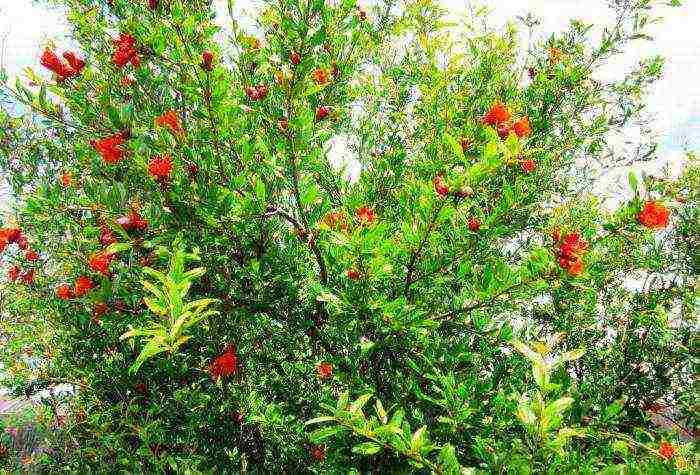
The best Azerbaijani varieties of pomegranate (photos are given in the article) are pink and red Gulusha. The pink variety has fruits weighing 220-250 grams, but sometimes there are much more round fruits. The juice yield from them reaches 54%. The grains of this variety are medium in size and have an excellent taste.
Gyulusha red has the shape of a bush (up to three meters in height). The fruits of the plant are large enough - 300-400 grams. They are covered with a pink thin crust. The fruit contains large grains, from which a bright red juice with a sweet and sour taste is obtained. The fruit ripens in October and can be stored for two to three months. The variety is also grown in Georgia and Turkmenistan.
Ak Dona Crimean
Currently, there are such varieties of pomegranate (photos are given by us in the article), which are cultivated in completely unusual regions. For example, Ak Dona Crimean is grown in the steppe Crimea. The fruits are oval and large in size. The variety is easily recognizable by the thinnest creamy peel with reddish spots on one side. The fruit has a thick and short neck. Pink-red grains have a characteristic sweet taste with barely noticeable sourness.This variety is grown even by amateur gardeners, since it is not too capricious. But in order to truly enjoy the ripe, tasty fruit, you need to choose the fruit that is soaked in the southern sun and is fully ripe.
Achik-anor
Achik-anor is a very small tree that produces fruits of irregular sizes when fruiting. They are round in shape, but taper imperceptibly at the base. This variety is interesting in that it has a completely unusual skin color: dark green with a carmine cover. The rind is very thick. Even in ripe fruits, it is carmine from the inside. Pomegranate seeds are very large, dark cherry color with a bright sweet and sour taste.
Cossack improved
The pomegranate tree has a fairly medium size and round fruits. The fruit has a greenish-creamy skin with specks and stripes around its entire circumference. Quite often, a carmine top color appears. The peel of the fruit is not thick at all, from the inside it has a creamy yellow tint. Large-sized pink-red grains have a characteristic sweet, pleasant sour taste.
Ahmar
It is believed that the most wonderful and delicious pomegranates are grown in Iran. One of the best sweet varieties is Ahmar. The plant grows up to four meters in height and blooms with vibrant red-orange flowers. The tree blooms from June to the very end of August. The fruits are covered with a thick green-pink skin and are of medium size. The fruit of this variety is characterized by pink light grains. The lighter the kernels, the sweeter they taste. According to experts, the sugar content in Ahmar pomegranate is so high that the variety occupies a leading position in this indicator.
Nar Sharin
Nar-sharin is similar in taste and description to Ahmar. But this variety is characterized by a light skin color, even in ripe fruits. On the outside, the skin is beige with pink splashes, and on the inside it is almost white. Pomegranate seeds are small enough but very sweet. Their color gradually goes from light pink to very dark. An interesting fact is that Iranian pomegranates grow in the wild, and they began to be cultivated not so long ago and only in the central region. The local population uses fruits plucked from wild plantings for food.
Dholka
The sweetest pomegranate in the world is Dholka. The plant grows in the wild in India. The fruits of the culture are very light, but with a slight pink tint. Oddly enough, but the fruit is modest in size and weighs only 180-220 grams. Pomegranate seeds in different fruits may differ in color. Their colors range from white to pale pink. In nature, the shrub grows to a height of no more than two meters.

In India, pomegranate is widely used in traditional medicine, since the standard of living of the population is low. From the roots of the plant, a remedy is prepared that relieves pain in case of bruises and fractures. And decoctions are used to treat dysentery.
Frost-resistant varieties
Many amateur gardeners are attracted by the amazing flowering of pomegranate trees, and therefore there is a desire to grow an exotic culture on the site. But are there frost-resistant varieties of pomegranate that can withstand winter in the middle lane? This question is asked by a large number of gardeners. Yes, there really are such varieties.
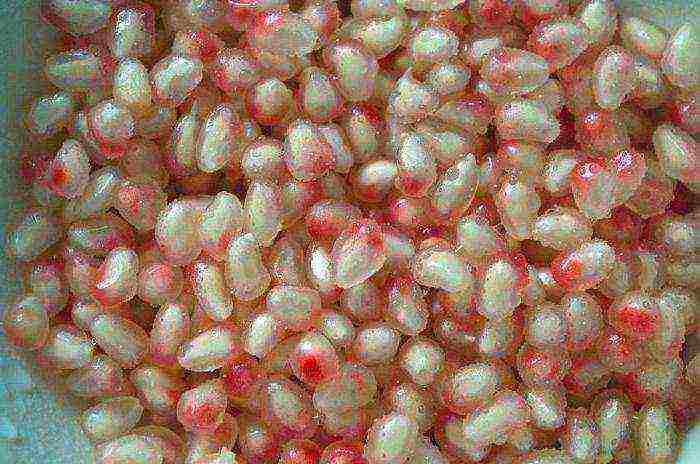
Average frost resistance requires an indispensable shelter of plants for the winter, otherwise the pomegranate simply cannot withstand low temperatures. But with proper care, nothing is impossible. The previously described varieties of Gyulusha pink and red, Ak Dona Crimean belong precisely to frost-resistant species, and therefore their cultivation can be safely tested in a summer cottage.
White variety of pomegranate
Very often people have a question about the existence of a white pomegranate. Is this myth or reality? In fact, there are pomegranate varieties with white grains and are successfully cultivated in southern countries and even in southern Italy and Spain.An example of such a miracle plant is Tuya Tish, the name is translated as "camel's tooth". Large grains are characteristic of the fruits of this variety, but still they are not quite white, as many imagine. At first glance, it may seem that the pomegranate is simply not ripe. But in fact, the nucleoli are very sweet and incredibly tasty. Similar fruits can be purchased in Spain and Egypt. The so-called white pomegranate is endowed with exactly the same beneficial properties as the regular red varieties.
Indoor grenades
Lovers of exotic home plants have probably heard that there are varieties of indoor pomegranate. These small plants can be successfully grown at home, enjoy the beauty of their bloom and even produce small fruits with proper care. It is worth noting that such varieties of pomegranate (described below) belong to dwarf forms, and therefore they can be considered as house plants. One of the varieties grown by the hostess is Punica Granatum Nana. The culture blooms and bears fruit throughout the year. When the plant reaches forty centimeter growth, you can already count on the first harvest. As a rule, from seven to ten fruits are tied on a bush, in the future there will be more of them. They are quite edible and reach a diameter of five centimeters.
Baby
Baby is probably the smallest pomegranate that can be grown at home. The plant has the shape of a bush. In height, it does not grow more than fifty centimeters. This variety is decorative and blooms amazingly beautifully. The bush during the dormant period (autumn) partially loses its foliage.

The plant requires constant care, annual thinning and trimming. If he doesn't like something, then it immediately reacts (foliage falls off), and therefore the grenade must be created as comfortable as possible. The plant blooms profusely and beautifully, giving single or group inflorescences. Each flower pleases for two or three days, after which it fades. Fruits are rarely formed. For one hundred flowers, for example, three or four fruits can be set.
Dwarf carthage
Dwarf Carthage is intended for indoor cultivation only. The plant is a small tree that needs to be cut regularly, preventing it from growing more than seventy centimeters. If the pomegranate is not cut, the branches will become thinner and the crown will lose its decorative appearance. In such a situation, the plant not only looks ugly, but also begins to bloom less often. The tree blooms amazingly beautifully.
Instead of an afterword
In our article, we tried to tell all the most interesting about such a wonderful plant as pomegranate. Of course, in our stores you can hardly find the fruits of all the varieties we have described, but we still hope that the information we offer will be useful. And, perhaps, you decide to purchase a seedling of a home exotic plant that will delight you with beautiful flowers.
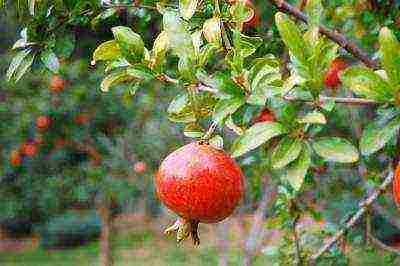 In the East, pomegranates are revered as a symbol of fertility and friendly feelings. In Turkey, a bride breaks a pomegranate at a wedding to find out how many children she will have in the marriage.
In the East, pomegranates are revered as a symbol of fertility and friendly feelings. In Turkey, a bride breaks a pomegranate at a wedding to find out how many children she will have in the marriage.
In India, pomegranate wood, a beautiful bright yellow color, is used to make various items and souvenirs that tourists are happy to buy.
In Israel, it is considered a sacred plant. No one has ever counted, but the Israelis are sure that there are exactly 613 seeds in a pomegranate (there are so many scriptures in the Qur'an).
Each nation has its own attitude to the pomegranate, but everyone loves it equally for the benefits it gives.
…
Excursion to the botanical garden
To get acquainted with the whole variety of varieties, you need visit the Nikitsky Botanical Garden, located on the Crimean peninsula.
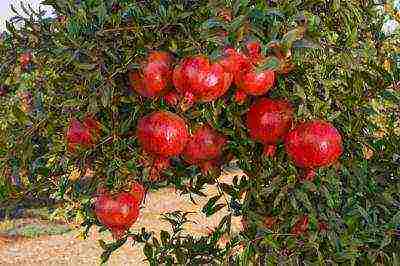 The collection, unique in its composition, includes about 340 varieties of pomegranate.
The collection, unique in its composition, includes about 340 varieties of pomegranate.
Here you can find breeding plants that scientists of the former Soviet Union have been working on for many years.Exotic varieties of pomegranate, brought from different parts of the world, grow next to them.
Astringent and sweet from Iran (Halva, Sharodi). Small-fruited, dwarf from Japan (Punicagranatumvar). Sweet and sour from Central Asia (Kyzym, Ulfa, Achik-Dona). Soft-boned, or generally seedless from America (Wonderful).
Of course, along with them, and domestic varieties... For high quality, early and medium ripening of fruits, high yield.
Breeding varieties Nikitsky early, Crimean stripy, Juicy 110 and others have firmly settled on the household plots of not only Russian, but also foreign farmers.
Pomegranate varieties: photo and description
Consider domestic and foreign varieties of pomegranate.
Baby
Baby variety the smallest of all offered for growing at home. The form of the plant is a bush. It grows no more than 50 cm in height.
Very decorative, beautifully blooming variety grenade. A shrub that partially loses its foliage during the dormant period in the fall, and requires mandatory annual cutting and thinning.
Photo of the Baby variety:
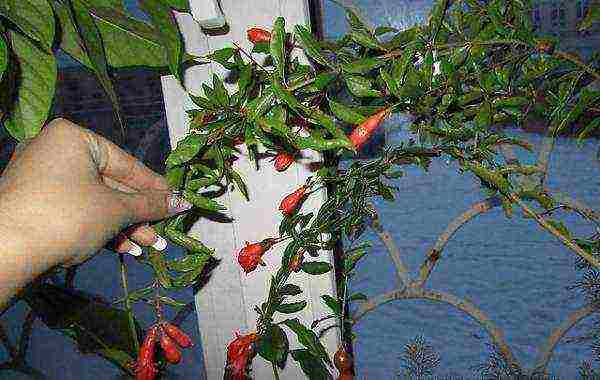
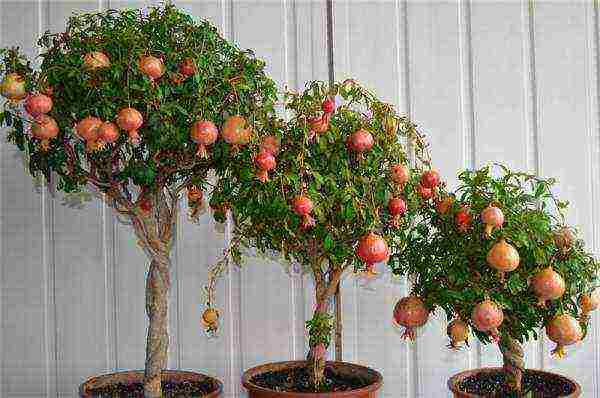
Dwarf Carthage
A plant variety specially designed for home growing. A small tree, by cutting it is desirable to keep the height of the plant no more than 60-70 cm.
If the plant is not cut, the branches become thinner, the small growth inside the crown creates an untidy, ugly look. The plant not only looks worse, but also blooms less often. The appearance of the plant during flowering is simply mesmerizing.
Variety Carthage
not whimsical, grows well and develops. With sufficient moisture and light, it bears fruit annually.
Photo of dwarf Carthage:


Ahmar
It is believed that the tastiest and sweetest fruits are from Iran. Ahmar belongs to the sweet Iranian varieties. The plant reaches a height of 4 meters. It blooms with red-orange flowers, not very elongated. Flowering lasts from mid-June to late August.
Fruits are of medium size, the peel is pink-green, thick. The grains are light pink. The lighter the grains, the sweeter the fruit.... It is believed that in terms of sugar content, Ahmar is in one of the first places.
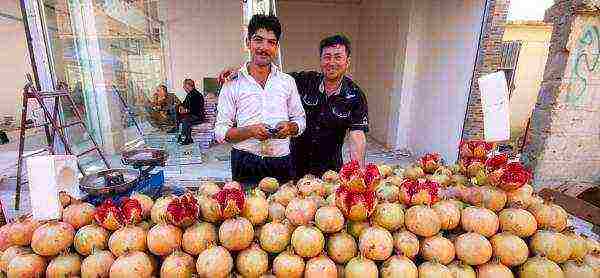
The local population appreciates it not only for the taste of the fruit. Thin branches are suitable for weaving baskets; high-quality dye was previously obtained from flowers. All parts of the plant used in traditional medicine.
Nar-Shirin
The Nar-Shirin variety is similar in description and taste to Akhmar. The peel of ripe fruits is pale. On the outside, it is pink-beige with beige-green splashes. Beige inside.
Nar-Shirin grains are small, round in shape. The color gradually fades from pale pink to dark. The variety is classified as sweet.
Iranian grenades most often grow in nature, they have recently been cultivated, mainly in the central regions. The local population uses the fruits of wild plantings for food.
Despite their good taste, they are inferior to other varieties, larger and more attractive. They are mainly used in the domestic market.
Dholka
The sweetest of all natural varieties... The homeland of the plant is India. Grows in wild plantings. The fruits are light with a pinkish tinge. Small in size. 180 - 220 grams. Grains range from white to light pink. The shrub is small, up to 2 meters high. Sheet 4-5 cm.
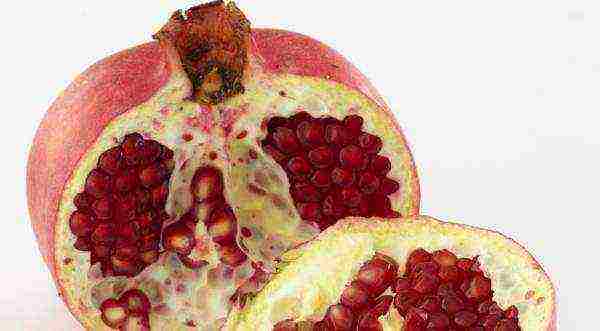
In Indian folk medicine for fractures, bruises, to relieve pain, it is used preparation made from pomegranate roots... The standard of living of ordinary people in India is very low, unsanitary conditions often lead to various diseases. Indian medicine men use decoctions of tree bark and roots to treat worms and various forms of dysentery.
Mangulati Sweet
With a slight sourness variety from Israel. It tastes good. Orange red. Fruit weight from 150 to 250 grams. The grains are pink-red. In Israel, the pomegranate tree is considered sacred.
It is a symbol of love and divine beauty. Cultivated plants of this variety give more large fruits up to 400 gr... With good care, it can grow up to 5 meters in height.
The Israelis produce pomegranate seed oil. It is widely used in cosmetology. On the basis of the oil, highly effective preparations for skin rejuvenation are created.
Seed oil is a strong antioxidant. Helps lower blood sugar levels. Promotes the initiation of the self-destruction mechanism of breast cancer cells.
Bedana
Another Indian variety. There is little information about Indian varieties, it is just known belongs to the group of sweet pomegranates... The fruits are small. Plants of wild plants. Used in the domestic market.
Achikanor (Achik-anor)
Refers to sweet and sour group pomegranates. Mid-season. Fruits are round, slightly narrowed towards the base, red-green in color, dark, cherry-colored grains, large in size. The juice tastes tart, pleasant. Quenches thirst well.
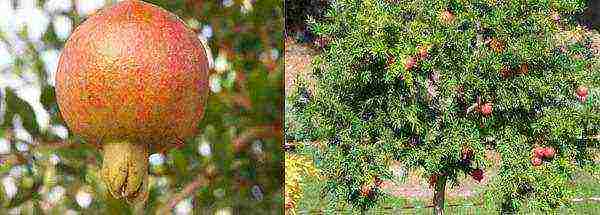
Achik-anar
Another consonant variety, similar in name. The bush of the plant is large, it grows more than 4.5 meters in height. The fruits are round. Big ones. Average weight of one fruit 450 grams... The peel of the fruit is red with green stripes. The grains are large red.
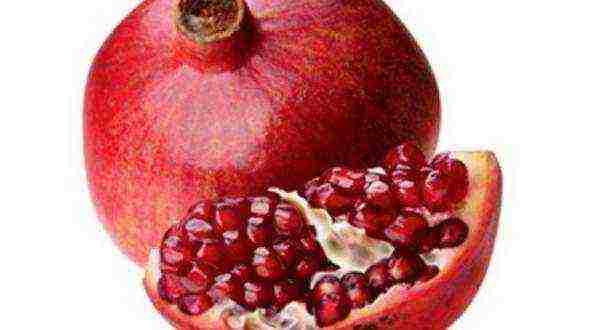
It tastes sweet but not sugary. The variety is mid-season. Harvesting begins in early October. From one bush, you can collect from 40 to 50 kg. fruits. The variety was created by Uzbek scientists.
Ak-Don
The plant is mid-season. Harvesting begins in the second half of October. The fruits are a little flattened, the peel is yellow-pink with red spots of different sizes, thick, on the inside painted in a bright lemon color. The grains are large, dark pink. It tastes sweet.
The plant itself is not very tall, but wide. The leaves are bright green, large, 5 - 7 cm. The homeland of this variety is called Central Asia.
Akdona
This garnet is also from Central Asia. For very large grains he was given second name - Tyuyatish, camel tooth... The fruit has a light skin with a delicate raspberry "blush". The grains are dark pink, elongated.
Blooms in red-orange elongated flowers. The flower's calyx has the shape of a cone, with bent edges.
Ak Dona (Crimean)
Zoned variety, bred in Nikitsky Botanical Garden... The fruits are large and round. With a thick and short neck. The peel is thin, creamy. One side is pale pink, on the other there are bright spots. The grains are dark pink, sweet with slightly noticeable sourness.
Photo of growing Ak Don:

The more you get to know different varieties of pomegranate, the more you want to grow them at home. Any sort of pomegranate
can be grown
on your windowsill.
Plant the seed of the pomegranate you like in the ground, and after a while it will sprout. But it is still better to use special varieties for home cultivation.
Garnet
, or the pomegranate tree (Punica) has long been considered a symbol of fertility, because under the hard red peel of this berry, hundreds of small juicy grains with a stone are hidden. Yes, pomegranate is a berry. It's just very big.

Pomegranate Pomegranate is a southern plant, it loves warmth and ripens in warm regions by the middle of autumn, if not later. Today, there are also frost-resistant and early ripening varieties, but growing a pomegranate tree in the middle lane in the open field is an activity for extreme lovers. However, in Russia there are also such.
Depending on the species and variety, as well as the region in which it was grown, pomegranate berries can be sour or sweet.
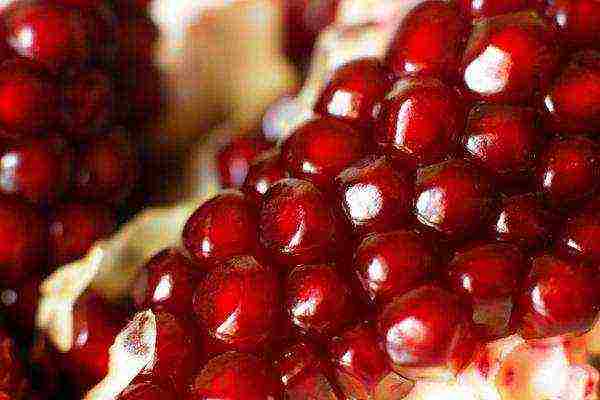
Depending on the variety and type, pomegranate berries can be sour or sweet.Sweet taste usually from pomegranates grown in Turkmenistan, Azerbaijan (near the Talysh mountains and Nachikhevan), Central Asia.
Acidic- Karabakh and Ganja (Western Azerbaijani) grenades. Georgian can also be recognized by their sour taste and pink flesh with white, slightly pinkish grains.
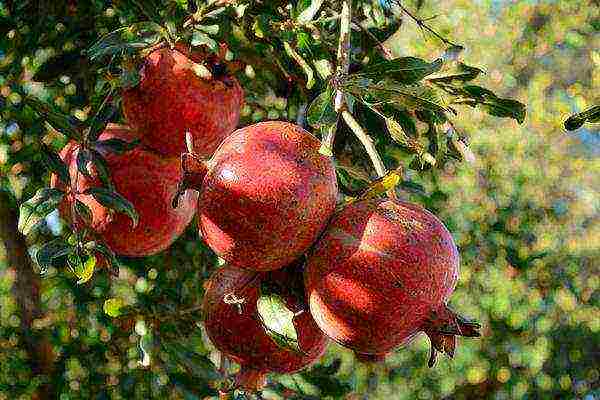
Ripe pomegranate fruits Pomegranate belongs to the Derbennikovye family. It is a deciduous shrub or a small tree up to 6 m high. Its branches are thin and have thorns on them.
The pomegranate has 2 main types of flowers: those that form an ovary (in the form of a jug), and those that do not form fruit (in the form of a bell). Infertile can also be distinguished by their small size and short pistil. They fall off quickly. There are also flowers of intermediate forms. The color of the flowers is orange-red.
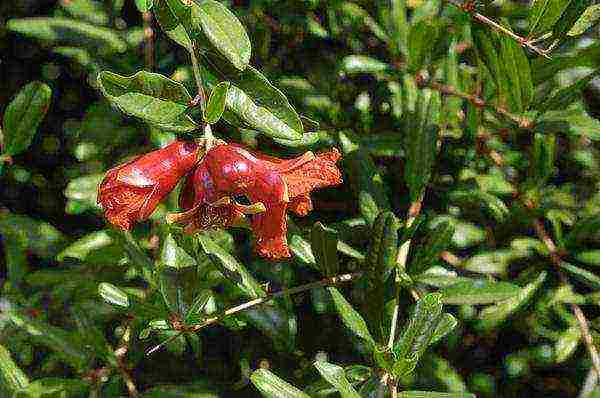
Blooming pomegranate Pomegranate tolerates drought well and can withstand a short-term drop in temperature to -17 ° C, but at the same time it suffers from shoots on which fruits (pomegranates) are formed. Therefore, it is grown mainly in the south.
Now there is a lot of debate about the possibility of growing pomegranate in central Russia. With a good shelter, of course, he can live more than one winter, but whether he will ever bloom with you is a big question. Below is a photo of a pomegranate planted in a garden at the age of two from a pot. It hibernates in the Moscow region for more than one winter in a row, but it has never bloomed yet.

Pomegranate in the Krasnogorsk region (Moscow region).
However, a craftsman from Shebekino V.M. Evdokimov overcame these difficulties and successfully grows pomegranates in the open field, receiving fruits weighing up to 550 g.
Planting a pomegranate
An important condition for growing pomegranates is the total amount of active temperatures of at least 3000 and about + 15 ° C in winter. It is heat that is the key to large and good fruits.

Young seedlings of pomegranate Pomegranate is undemanding to soil. It can even grow in wet conditions. But still, you should prepare the soil, arrange drainage so that moisture is removed, and not stagnant at the roots. Drainage can be crushed stone or expanded clay, less often gravel. The soil for pomegranate may have an alkaline reaction and the structure of loam, but in this case it must be properly "charged" with organic and mineral fertilizers.

Pomegranate is undemanding to soil
- A planting hole is dug in the same way as for many fruit trees (60 × 70 cm);
- A fertile soil layer (about 15 cm) and humus mixed with earth (somewhere a little more than a bucket) are poured at the bottom;
- The roots are straightened and carefully sprinkled with earth;
- After planting, the soil is well watered and mulched with dry weeds, straw or humus. This will help the moisture stay in the soil longer.
If you will be covering a pomegranate for the winter, it makes sense to plant the seedling at a slope of 60-45 ° to the south side.
Pomegranate care
Loosening
should be carried out
in the first years after planting ... It is especially useful during the growing season.
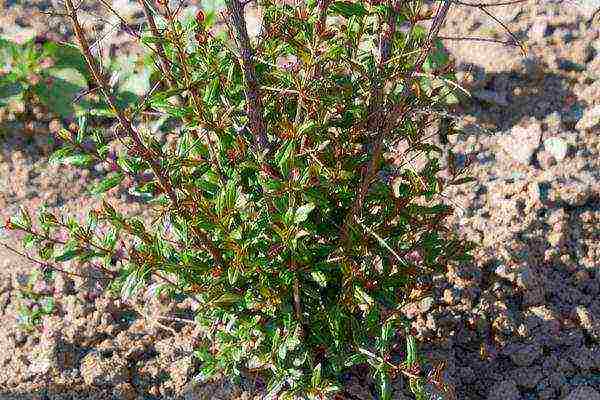
In the first years after planting, the soil around the pomegranate must be loosened
Watering
Water the pomegranate sparingly. From the second growing season, the slightest overdrying of the soil will lead to cracking of the fruits.
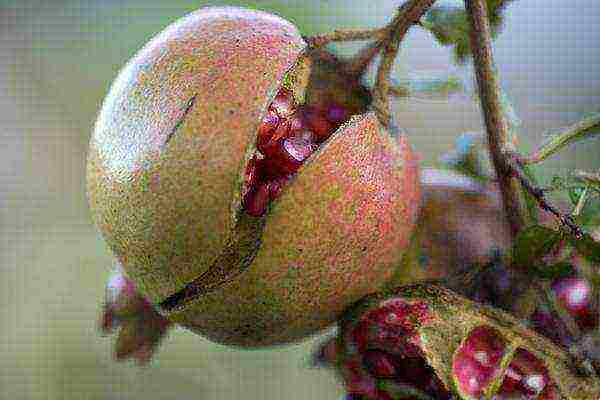
Overdrying the soil causes the pomegranate fruit to crack
Shelter for the winter
For the winter, you can pull off the branches with burlap. If the seedling was planted at an angle, in the fall it bends to the ground and is insulated with earth, like grapes. Starting at the top, the plant is gently bent to the ground. At the same time, about 4 shovels of earth are poured onto the top, after which the whole plant is covered with earth from the row spacing with a layer of about 20 cm.In the spring, when the threat of frost has passed, the plant is gradually, from bottom to top, freed from shelter.
If shelter for the winter is not planned, the one-year-old seedling should be spud to a height of about 15 cm.
Some gardeners insulate pomegranate seedlings with one or more tires stacked on top of each other.
Crown formation and pruning
The shape of a bush is optimal for a pomegranate, when the plant has a maximum of 6 trunks. This shape helps to avoid injury in case of shelter for the winter. They try to give the plant an inclined fan shape. But with active growth, thickening of the crown and the appearance of branches that can break or grow inward are inevitable. To do this, remove the extra branches.
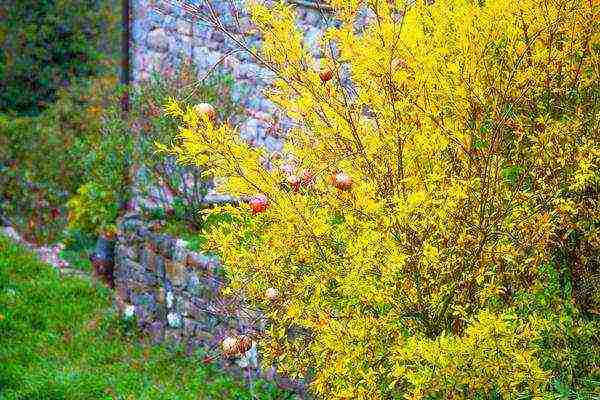
The shape of a bush is optimal for a pomegranate.
Root growth and thickening shoots must also be removed.
Like many fruit plants, the pomegranate is aging and needs rejuvenating pruning.This usually happens every 20 years. To do this, all branches above the ground are cut, thereby stimulating the growth of new ones and an increase in the amount of harvest.
Fertilization
The bulk of fertilizers are applied to the ground before planting, but if the soil is poor, from mid-June the plant is fed with phosphorus-potassium or nitrogen-containing fertilizers. In summer, you can apply liquid fertilizers while watering. In the fall, when you dig up the trunk circles, also feed the pomegranate.
Reproduction of pomegranate
Pomegranate multiplies
cuttings
(vegetatively) and seeds
.
Seed breeding method
Take seeds from a fresh, well-ripened fruit, you do not need to peel them.
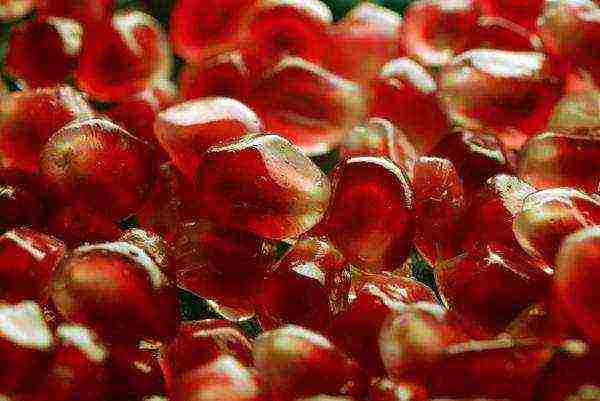
Pomegranate seeds
- Spread the seeds over the surface of the moistened soil, dusting them with soil in a layer of about 1.5 cm.
- While the seeds are germinating, the soil should not be allowed to dry out.
- When the seeds germinate and reach a height of 3 cm, they are dived or transplanted so that the distance between shoots is at least 4 cm.
- When the seedlings grow so much that there are no gaps between the seedlings, they are dived again.
Propagation by cuttings
Cuttings are cut from annual lignified shoots of young plants. The size of the cutting is about 25 cm. For these purposes, you can also use the shoots. Well-fertilized and drained plots of land are suitable for rooting the cuttings. The cutting should be rooted in a soil warmed up to +2 ° C to a depth of about 10 cm. In this case, 1 internode should remain above the soil surface. Green twigs take root in late May - early June.
Collection and storage of the harvest of pomegranates
In the south of Russia (in some regions of the Kuban) and in the Crimea, fruits begin to be harvested in October.
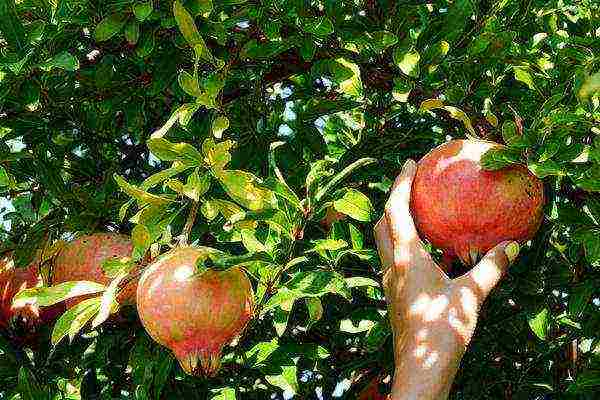
Harvesting pomegranates At this time, they reach maximum maturity, the grains are full of sugars, and the rind takes on a rich red or yellow-pinkish speckled color.
When fully ripe, the pomegranate fruits may crack, if you collect them for storage, you need to be in time before this moment.
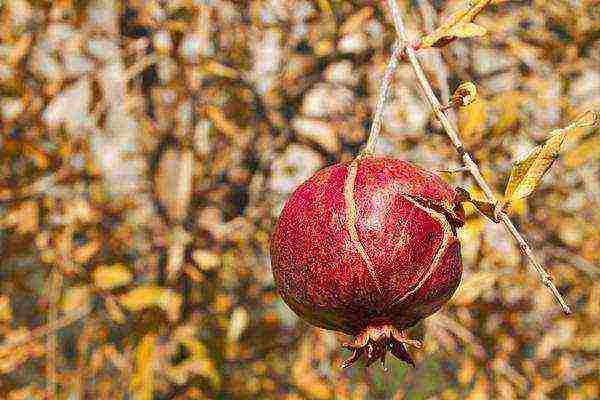
Fully ripe pomegranates can crack Pomegranates have excellent shelf life and long lasting freshness.

The pomegranate is perfectly stored and retains freshness for a long time. Fruits cannot be stored at subzero temperatures, otherwise they can rot. A ventilated room with an air temperature of +2 ° C will be optimal.
The most common varieties of pomegranate
There are many different varieties of this southern plant in the world. Each country loves its own variety of pomegranate, but there are also well-known varieties loved by many.
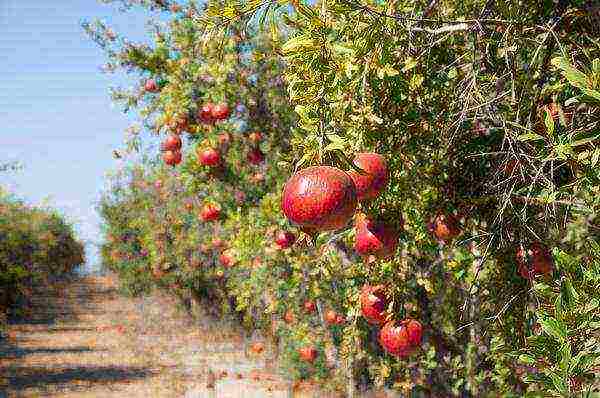
There are many varieties of pomegranate in the world. Pomegranate varieties are divided into those with hard seeds in juicy grains, and those with soft seeds. Hard bones are considered a sign of poor quality. It's like a wild apple tree and a grafted apple tree of a good variety. Soft-seeded varieties are very moody and require maintenance. But the quality of their fruits is also amazing.
‘Guleisha pink’ and ‘Guleisha red’
'Gyuleisha' ('Gyulosha') is the best variety cultivated in Azerbaijan. Fruits are elongated-rounded, thin skin. In ‘Güleisha pink’ it is pink, and in ‘Güleisha red’ it is carmine red with streaks (stripes) at the base of the fruit. The grains are juicy, dark purple in color.

Pomegranate fruits of the ‘Gyuleisha (Gyulosha) pink’ variety.
‘Ak Dona Krymskaya’
An excellent variety for growing in the vicinity of Crimea. It is cultivated even in the steppe part of the Crimea, but requires shelter for the winter. Differs in large oval fruits. You will recognize the cultivar by its creamy thin skin with red spots and blush on one side (usually the south). And his neck is short and thick.

‘Ak Dona Krymskaya’.
‘Kizil-anor’
The variety is early maturing, cultivated in Uzbekistan. Plus the variety is in its early maturity. In early October, you can already harvest, fruits - from small to large. The skin is pink-scarlet, the grains are red, medium-sized and sweet and sour in taste.
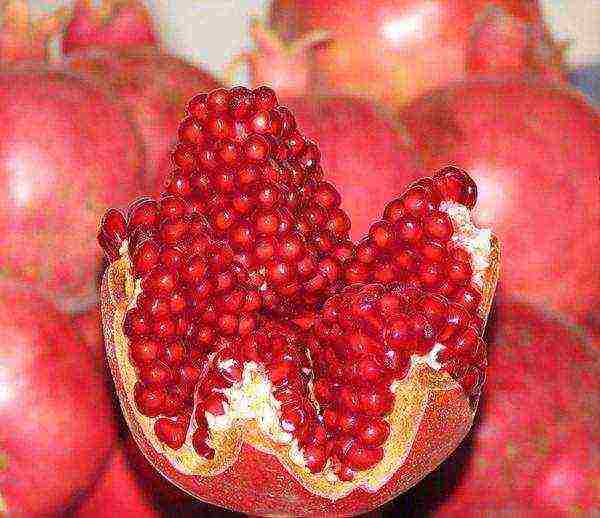
Dwarf pomegranate (Punica granatum f. Nana)
Like many fruit crops, the pomegranate has a dwarf form that is commonly grown as a houseplant, Punica granatum f. nana. It pleases with flowers and bears fruit almost all year round, already with a growth of 40 cm, you can get a good harvest of 7-10 fruits, then more. The fruits are quite edible, their diameter is up to 5 cm.
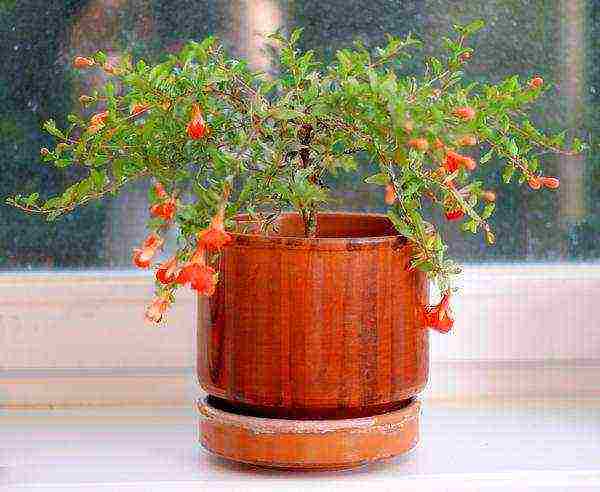
Dwarf pomegranate So, the basic information about pomegranates and their cultivation is revealed. Admit it, who else has pomegranates growing? 🙂
When one of our loved ones needs to raise hemoglobin or improve their health after an illness, we think of pomegranate juice or rush to buy this strange large fruit in a strong peel with many ruby seeds. Common pomegranate is an exotic plant for us that grows in warm countries, only its surprisingly useful fruits come to us. But there are gardeners who do not recognize the difficulties, they manage to grow some varieties of pomegranate in seemingly completely inappropriate conditions in the middle lane.
Product description
It is believed that the pomegranate came to us from the territory of modern Tunisia, although it is difficult to say anything for sure, since this culture has existed for more than three thousand years, about which there are many different kinds of evidence. A picturesque bush or large tree can grow for 100 years and bear fruit for a very long time. From the middle of autumn, ripe fruits have been on store shelves - large fruits with thick, strong skins of different colors. They are sandy-yellow, yellow-orange, bright red, red-brown. Numerous grains, inside of which there may be about a thousand, differ in color - different varieties of pomegranate differ in the intensity of the red color or its almost complete absence. So, the grains are almost white, pale pink, bright red, ruby, almost black. The taste can also be sweet, sweet and sour, or even very sour.
Some lovers grow indoor varieties that are compact and decorative, but the fruits, although edible, are not particularly sweet. Pomegranate loves a lot of sunlight and heat, its growing season lasts up to 8 - 9 months, and frost below -15 degrees can be fatal. Therefore, north of the subtropics, this crop is grown in heated greenhouses and requires too much attention, which is why it is not widespread.
Video "Benefit"
From the video you will find out what is the use of this fruit.
Types and varieties
There are two main varieties of pomegranate - with hard and soft seeds. There are early ripening varieties that are grown in our country, they do not differ in special requirements for conditions. But varieties with soft bones are considered more capricious, they require much more attention and trouble. Not every climate and far from every soil can suit them.
"Kizil-anor"
Pomegranates of this variety come to us from Uzbekistan. They ripen by early October - this variety is considered early ripening. Fruits of different sizes are distinguished by a pink-scarlet skin, red grains have a sweet and sour taste.
"Ak Dona Krymskaya"
It grows well in the steppes of Crimea, but the bushes need to be covered for the winter. Large oval fruits are covered with a thin creamy skin with red spots. The pink-red grains are sweet with a barely noticeable sourness.
"Gyuleisha pink"
Cultivated in Azerbaijan. On high bushes up to 3 meters with straight thorny shoots, round or rounded-elongated fruits grow with an average weight of about 250 g, but there are also more than 600 g. Fruits are covered with a thin, very light crust, creamy white, sometimes with pink stripes. The grains are small, dark cherry with a sweet and sour taste. The harvest is stored for no more than four months.
"Guleisha red"
The pomegranate variety "Gyuleisha red" is usually round in shape with a carmine-red skin, the stripes are well pronounced at the very top. The grains are large, dark cherry, reminiscent of "Pink Gyuleisha".Both of these varieties are considered Azerbaijani.
Bala Mursal
Also an Azerbaijani variety, it is considered one of the best in taste. Slightly flattened medium-sized fruits (about 250 g) delight with a light raspberry-red blush. The kernels can be red or raspberry, contain up to 16 percent sugars, ripen by mid-October. More than 20 kg of fruits are usually obtained from one bush.
"Cossack Superior"
It is usually cultivated as a medium-sized tree with large, rounded fruits. The skin of the fruit is greenish-creamy, with streaks, stripes, spots and specks all over the surface. A carmine red integumentary color often appears. The rind is not thick, creamy yellow inside, and the grains are large, pink-red. The taste is very pleasant, rich, sweet with noticeable acidity.
"Achik-Anor"
It is a small tree with irregular fruits, round but noticeably tapering towards the base. The skin of the fruit has a dark green color, which is unusual for us, with a carmine cover, so the top of the fruit is completely dark carmine. The skin is thick even in a ripe pomegranate, carmine from the inside, large grains have a dark cherry color and a bright sweet and sour taste.
"Nikitsky Early"
It is grown in a medium sized tree with very large fruits. The skin of medium thickness is painted with an even carmine-red color, and the grains are very small, dark cherry. The taste of the grains seems to be sweeter than the sweet and sour juice from them. The fruit differs from other varieties by its high thick neck with a large calyx.
Benefit and harm
Pomegranate juice or the pulp of its berries are very useful, they contain so many substances that a person needs, that they contribute to overcoming many diseases and the general strengthening of the body.
The use of these exotic fruits strengthens the immune system, improves the functioning of the heart and blood vessels, stabilizes the stomach and intestines, lowers blood pressure, slows down the general aging of the body, and is an excellent prevention of cancer.
Fruits contain potassium, iron, calcium, phosphorus, sodium, magnesium and even valuable amino acids like those found only in meat, so pomegranates should be consumed by vegetarians. Vitamins A, C, E, P and B groups strengthen blood vessels, calm nerves, improve blood composition, and rejuvenate the skin. Sugars and acids make the grains not only tasty, they are easily digested, enriching us with energy. True, acids can harm tooth enamel, so the juice (it is consumed with diluted water) should be drunk through a straw, and after eating the grains, you should brush your teeth or at least rinse your mouth with clean water.
For a long time, all parts of the plant were used for treatment, and folk medicine uses the fruit one hundred percent. Bones relieve headaches and normalize blood pressure. White septa calms the nerves and increases stress resistance. The skin relieves indigestion, heals burns and expels worms.
Pomegranate juice can induce appetite and improve digestion. And the dried skin or its broth can get rid of pathogenic microorganisms, they even cope with dysentery bacillus. The high content of vitamins allows pomegranate to fight cholesterol, make the walls of blood vessels clean and elastic. Organic acids and tannins make pomegranate indispensable in the fight against colds. A decoction of the skin or diluted juice is used for rinsing with tonsillitis, laryngitis, stomatitis. A decoction of the crushed bark reduces inflammation, eases the condition with various diseases of the vessels, kidneys, and liver. Pomegranate removes radiation and slows down aging.
But a fruit with such amazing activity of all its components cannot be harmless. It should be used with great caution by people who have high acidity or have stomach and duodenal ulcers.Powders, decoctions, skin infusions must be taken very carefully, an overdose can lead to unpleasant consequences - dizziness, weakness, even convulsions.
Nursing mothers should limit the use of pomegranate, because the child may have allergies or simply disrupt the bowel function, it is best to drink diluted juice in moderate doses.
Children from 9 months of age are given juice, but it must also be diluted.
People prone to allergies of various kinds should not uncontrollably drink pomegranate juice or feast on grains, it is worth starting with small portions to make sure there is no allergic reaction.
Pomegranate is a very useful exotic fruit, but its use will bring more benefits if it is regular, and not excessive, of course, in the absence of contraindications.
Video "Sorts"
From the video you will learn about the varieties of this fruit.

